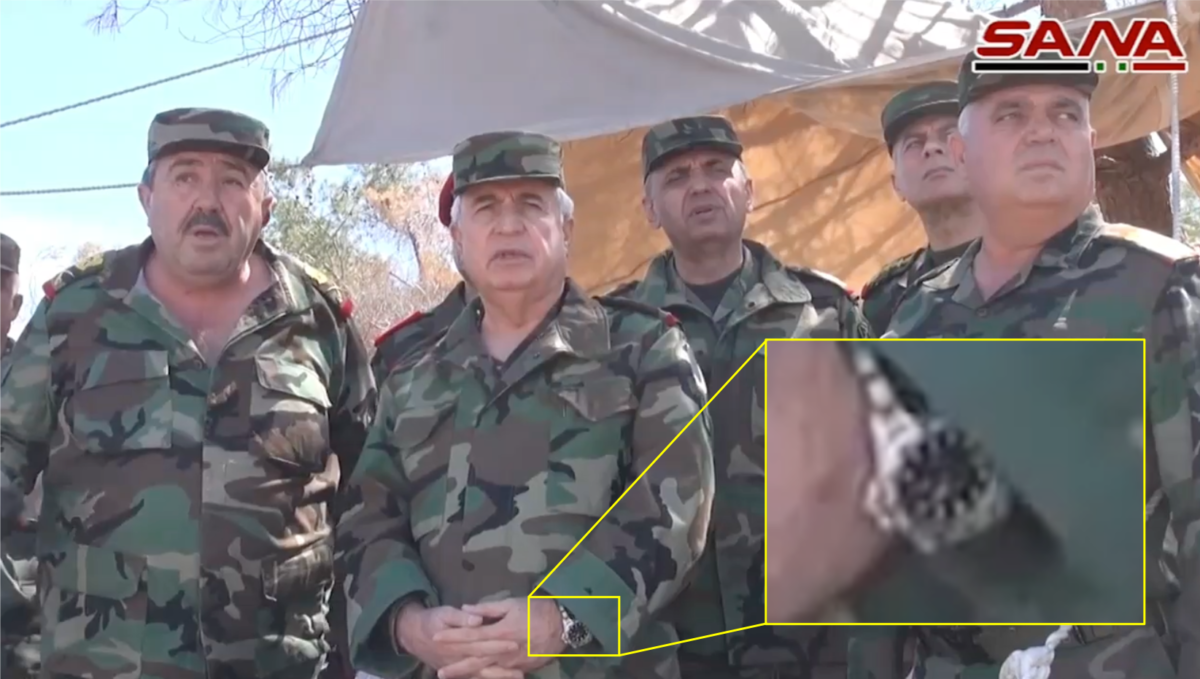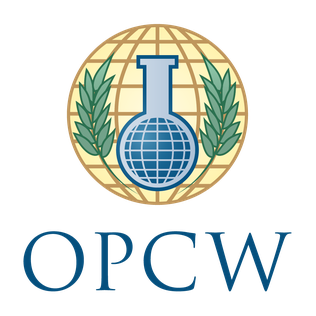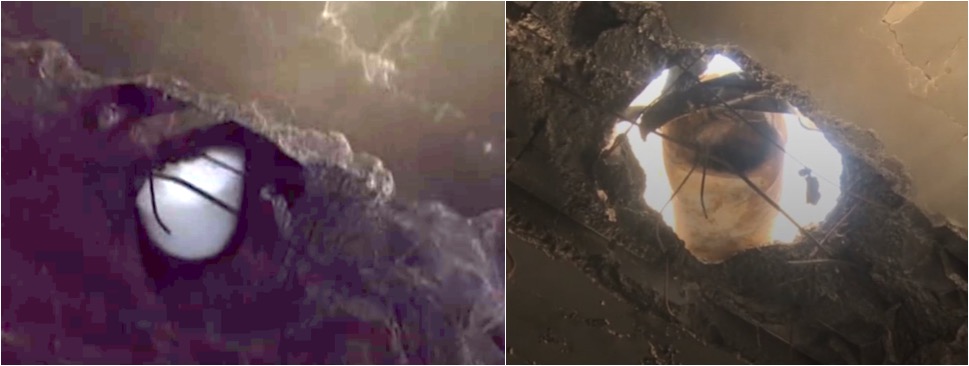The Chemical Munitions Used By the Syrian Government 2012-2018
The conflict in Syria has seen the widespread use of chemical weapons by Syrian government forces since the end of 2012, with a surprising, and often very unusual, range of chemical munitions used. This article examines the chemical munitions documented through open sources, primarily used to deploy Sarin and chlorine gas.
Volcano Rockets
Known Period of Use – December 2012 to August 2013
The most notorious chemical attack of the Syrian conflict was the August 21st 2013 Sarin attacks in Damascus. Two types of rockets were used to deliver the Sarin used in the attacks, M14 artillery rockets, described below, and Volcano Rockets, a type of rocket unique to Syrian government forces.
Following the August 21st 2013 attacks, local groups filmed and photographed multiple examples of the remains of Volcano Rockets used in the attacks:
Sarin and Sarin byproducts were found in samples examined by the United Nations Mission to Investigate Allegations of the Use of Chemical Weapons in the Syrian Arab Republic, confirming the muntions contained Sarin. This same munition was also used in previous chemical attacks, including a chemical attack reported in Adra, Damascus, on August 5th 2013:
The remains of the same munition were also documented in a number of other incidents, the earliest known example being published in December 2012:
While the munition in the above video is clearly the same design, there’s no details about the incident beyond videos and photographs published of the munition. Because of the unusual design of the rockets, it was alleged by some that these rockets were created by opposition groups as part of a false flag attack to draw foreign governments into the conflict. This hypothesis can be easily rejected, as the explosive version of the rockets are shown in use by pro-government forces in multiple videos posted online by Syrian government forces and pro-Syrian media:
https://www.youtube.com/watch?v=5HWXqd69Vsc
A close examination of images of chemical Volcano rockets and explosive Volcano rockets show that they are virtually identical, with the only significant difference being the design of the warhead, depending on the payload. Details like the type of welding used, position, size, and arrangement of bolts, and the presence of what appears to be a fuzing-related port on the rear of the warhead are shared by both types of the munition. There is also no evidence that either type of these munitions was captured by Syrian opposition forces, and the Syrian government has told the OPCW and UN that they have not lost control of any of their chemical weapons.
Following the August 21st 2013 there were no more incidents of the chemical version of the Volcano Rocket being used in chemical attacks, although multiple videos have been published pro-government media and armed groups showing the use of the explosive version of this rocket, including a larger version of the same design:
140mm M14 Artillery Rockets
Known Period of Use – August 21st 2013
The second type of rocket used in the August 21st 2013 Sarin attacks was the 140mm M14 Artillery Rocket. Unlike the Volcano Rocket, the M14 is a well documented munition original manufactured by the Soviet Union, and coming in a number of variations, including a type fitted with a Sarin warhead:
A Human Rights Watch investigation confirmed the Syrian government had M14 Artillery Rockets in their stockpiles, and the August 21st 2013 attack was the only documented instance of M14 Artillery Rockets being used in the Syrian conflict, either for conventional attacks or chemical attacks.
Helicopter Dropped Sarin Packages
Known Period of Use – April 2013
The most unusual chemical munitions used by the Syrian government were documented in two attacks in April 2013. It was reported that on April 13th 2013 in Sheikh Maghsoud, Aleppo, and Saraqib on April 29th 2013 helicopters dropped packages containing grenades containing chemical agents. The objects themselves appear to have been different designs of grenades placed inside a cinder-block and/or a box. The remains of this construct were filmed at one of the Saraqib impact sites:
Similar white debris was filmed after the Sheikh Maghsoud attack:
Remains of a white grenade were recorded at both incidents, as shown below:
In addition, remains of other grenade-like munitions were documented at the sites of the attacks, and a French government report published in 2017 revealed that French intelligence had acquired one of the munitions used in the Saraqib attack that hadn’t detonated:
The French report stated “The chemical analyses carried out showed that it contained a solid and liquid mix of approximately 100ml of sarin at an estimated purity of 60%. Hexamine, DF and a secondary product, DIMP, were also identified. Modelling, on the basis of the crater’s characteristics, confirmed with a very high level of confidence that it was dropped from the air.”
The use of Sarin was further confirmed in a December 2013 UN report which detailed findings of an autopsy of one of the victims, that “clearly indicated signatures of a previous Sarin exposure.”
Syrian Chemical Aerial Bombs
Known Period of Use – March to April 2017
Following Sarin attacks in Al-Lataminah on March 30th 2017 and Khan Sheikhoun on April 4th 2017 debris was documented that indicates a specific type of Syrian chemical aerial bomb was used in the attacks. Remains of a filling cap, identified as being “uniquely consistent with Syrian chemical aerial bombs” by the OPCW-UN JIM in their report on the April 4th 2017 Khan Sheikhoun attack, were documented in both the Al-Lataminah attack and Khan Sheikhoun attack:
Additional debris documented at the site of the Al-Lataminah Sarin attack allowed for the type of Syrian chemical aerial bomb to be identified, thanks to efforts by the Russian government to claim the OPCW-UN JIM’s report on the Khan Sheikhoun attack was wrong. During a lengthy press conference on November 2nd 2017, the Russian Foreign Ministry, Ministry of Defence and the Ministry for Industry and Trade presented its response to the Organisation for the Prohibition of Chemical Weapons – UN Joint Mission (OPCW-UN JIM) report on the Khan Sheikhoun Sarin attack. The presentation included a series of slides, which included diagrams of two types of chemical bombs, designated the MYM6000 and M4000. The slides from the presentation, with a clearer version of the bomb diagrams, were published online:
The debris matched various features visible in the diagram of the M4000 bomb, including the width and configuration of the tail fins:
This design is consistent with the description of Syrian chemical aerial bombs in the Mediapart article “How Assad regime built chemical arsenal with aid of Germany and other countries“:
“It also meant that engineers from the SSRC also had to design bombs that were specific for sarin, and which were quite different to ordinary munitions. “On the outside, they resemble conventional bombs of 250 and 500 kilos of TNT,” explained one of them. “But inside they were totally different, divided into two compartments. The first, at the front, carried the DF. The second, at the rear, [contained] the isopropyl and hexamine. This mixture is stirred together by a stirring rod that can be activated by sort of crank at the rear of the bomb. When the two compartments are filled up, a technician winds the crank which advances the stirring rod to the point it breaks the wall of mica. The sarin synthesis reaction is set off inside the bomb, placed under a cold shower and maintained within a very precise temperature range which is controlled by a laser thermometer,” continued the former SSRC source. “After which, all that’s left is to introduce, in the allocated hold at the point of the bomb, the explosive charge and detonator – altimetric, chronometric or other – and to place the bomb under the wing of the plane. The load must be very precisely measured. If it is too big, the heat given off can cause the decomposition of the product, or the formation of a cloud of gas too far from the ground, which would render it ineffective. In principle, a 250-kilo bomb contains 133 litres of sarin, a few kilos of TNT and a ballast to preserve the aerodynamic characteristics of the weapon. A 500-kilo bomb contains 266 litres of sarin. The ideal altitude for the explosion of the bomb is about 60 metres.””
Chlorine Rockets
Known Period of Use – January 2017 to February 2018
Two types of munitions have been documented in relation to the dozens of chlorine attacks that have taken place during the conflict in Syria. In January 2017, the remains of a surface to surface rocket were documented following a reported chlorine attack in Al-Marj, Damascus:
The rocket is based on a re-purposed Iranian 107mm rocket, with the warhead removed and replaced by a pressurised gas cylinder, and tail fins added to the base of the rocket motor. The same design of munition was documented in later Chlorine Rocket attacks, including a series of attacks that took place in Douma, Damascus in January and February 2018, where multiple examples of the same rocket were documented:
Explosive variants of the same type of munition used by pro-government forces in Damascus, with identical rocket motor and tail fin configurations, were posted to the Syrian Reporter Facebook group:
The use of this type of chlorine rocket seems restricted to the Damascus area, with no documented sightings anywhere else in Syria.
Chlorine Aerial Bombs
Known Period of Use – Ongoing since April 2014
Chlorine Aerial Bombs are the most widely used chemical munition used in the conflict in Syria, documented at dozens of incidents since April 2014. Over time, the configuration of these munitions has evolved as the design has become more refined by Syrian government forces. The initial uses of these munitions were documented in several attacks that took place in April 2014 in the Idlib and Hama regions, a number of which were confirmed by the OPCW-UN JIM as being the responsibility of the Syrian government. In these earlier attacks, chlorine cylinder were placed inside barrel bomb casings, which at that point in the conflict used a consistent design. There were a number of configurations for this set up, for example in the example below we can see detcord has been wrapped around the neck of the cylinder, likely to cause a rupture on impact:
A later evolution of this design was documented in an OPCW-FFM report examining claims of chemical weapon use in Spring 2015, detailed in JP Zanders’ The Trench:
“The configuration consists of 9 gas cylinders (green) presumably filled with poisonous chemicals. The report suggests that they may have been filled with a chlorine or chloride containing compound. The flasks with potassium permanganate (pink) would then have been used to oxidise the chlorine containing compound, resulting in Cl2. The potassium permanganate may be responsible for the purple–red colour occasionally seen in pictures and video footage of impact sites.”
A diagram of the configuration is shown below:
A year later this design appears to have been abandoned, with multiple instances of chlorine gas cylinders documented in the aftermath of chlorine attacks without the barrel bomb casings previously associated with the attacks. Human Rights Watch documented a number of examples used in the siege of Aleppo in late 2016:

Images of chlorine cylinders used in alleged chlorine attacks in Aleppo (source)
The Masaken Hanano November 16th 2016 and Karm al-Jazmati November 23rd 2016 attacks both have metal structures visible on the exterior of the cylinders, with the Karm al-Jazmati providing the most complete example:

Handout photo provided to Reuters on February 13, 2017, by Human Rights Watch claiming to show remnant of yellow gas cylinder found in Masaken Hanano, Aleppo, Syria after a chlorine attack on November 18, 2016. Courtesy of Human Rights Watch/Handout via REUTERS
A near identical structure was seen in relation to the chlorine cylinders used in the April 7th 2018 Douma, Damascus, chemical attack:
The evolution of the design of chlorine aerial bombs is not dissimilar to the development of barrel bombs, where during their initial use there was a great deal of variation in design until a standard design was settled on. With these developments in their design, aerial chlorine bombs have become the preferred chemical weapon of the Syrian military. The recent OPCW FFM report on the February 4th 2018 Saraqib chlorine attack, which confirmed the same type of aerial chlorine bombs were used, also showed that chemical tests of samples from the attack site and munitions indicated there were signs of Sarin byproducts, strongly indicating Sarin was also used along side chlorine. As of yet, the delivery method for that Sarin has yet to be identified.
Bellingcat’s research for this publication was supported by PAX for Peace.











